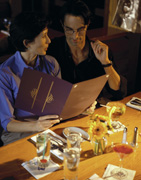
TUESDAY, June 3, 2014 (HealthDay News) — Norovirus, the so-called “cruise ship virus,” is more often caused by infected restaurant workers than outbreaks on the high seas, U.S. health officials said Tuesday.
Just 1 percent of more than 1,000 food-borne outbreaks examined by the federal Centers for Disease Control and Prevention were traced to a cruise ship. Most outbreaks were caused by infected kitchen employees touching food with their bare hands, according to a new agency report.
The virus, the leading cause of food poisoning outbreaks in the United States, sickens at least 20 million Americans a year with vomiting and diarrhea.
Dr. Aron Hall, who’s with the CDC’s division of viral diseases, said at a Tuesday news conference that probably many more cases of norovirus occur in the United States each year but go unreported.
Better hygiene practices by restaurant workers are needed to prevent these outbreaks, and agency officials said sick employees — workers with diarrhea and vomiting — must stay home from work.
Norovirus is often spread through the “fecal-oral” route, according to the CDC.
“Norovirus is one tough bug,” said CDC Director Dr. Tom Frieden during the press briefing.
Most people are infected by having close contact with an infected person or by eating contaminated food, Frieden noted. And outbreaks of norovirus typically occur in places where food is served, he said.
For the report, CDC researchers looked at norovirus outbreaks caused by contaminated food from 2009 to 2012 and included in CDC’s National Outbreak Reporting System.
“Restaurants accounted for nearly two-thirds of the outbreaks, and catering or banquet facilities accounted for 17 percent,” Frieden said.
Among 520 of the outbreaks, food workers were implicated in 70 percent of the cases. Of these, 54 percent involved food workers touching ready-to-eat foods with their bare hands, according to the report.
Among 324 outbreaks in which a specific food was implicated, more than 90 percent of the contamination occurred during final preparation, such as making a sandwich with raw and already cooked ingredients. Another 75 percent occurred in foods eaten raw, such as leafy vegetables, fruits and oysters.
Dr. Marc Siegel, an associate professor of medicine at NYU Langone Medical Center in New York City, said the norovirus is highly contagious.
“It only takes a tiny bit of norovirus to infect a lot of people. If you’ve been to a restaurant that made you sick, don’t go back there,” he said.
To help reduce outbreaks of norovirus, the CDC recommends:
- Making sure food service workers wash their hands and use disposable gloves.
- Certifying kitchen managers and training food service workers in food safety practices.
- Requiring food service workers to stay home when sick with vomiting and diarrhea for at least 48 hours after symptoms stop.
“We do know how to stop norovirus from contaminating our food. Everyone should be able to go out and eat without worrying about whether their food is safe,” Frieden said.
More information
For more information on norovirus, visit the U.S. Centers for Disease Control and Prevention.
Copyright © 2025 HealthDay. All rights reserved.

